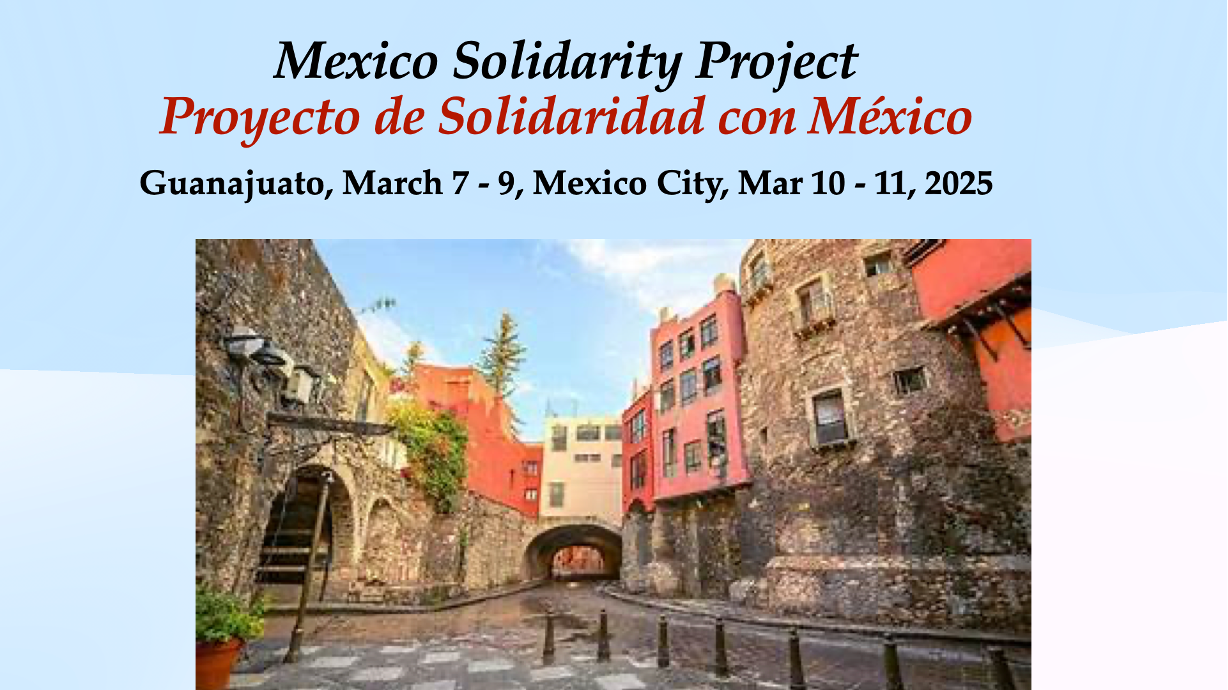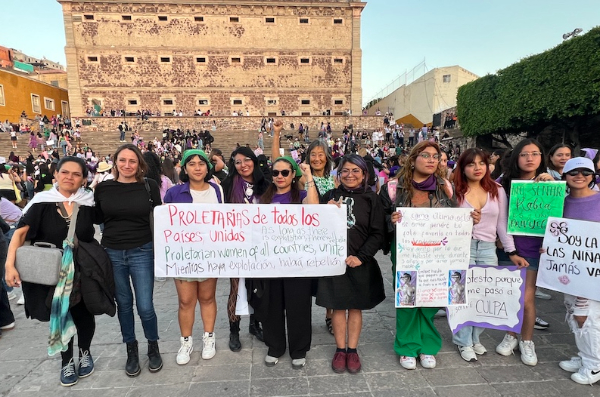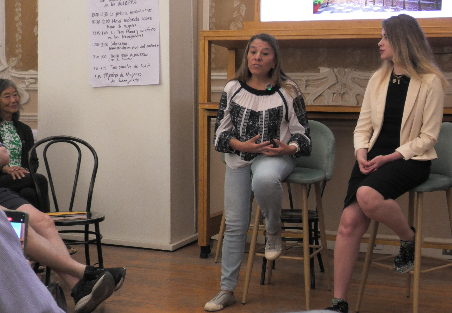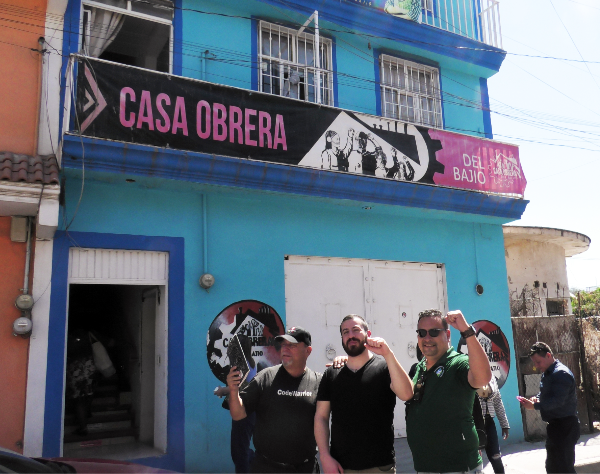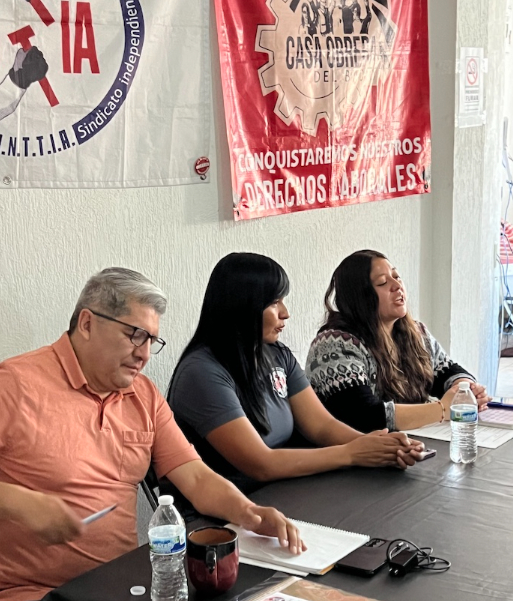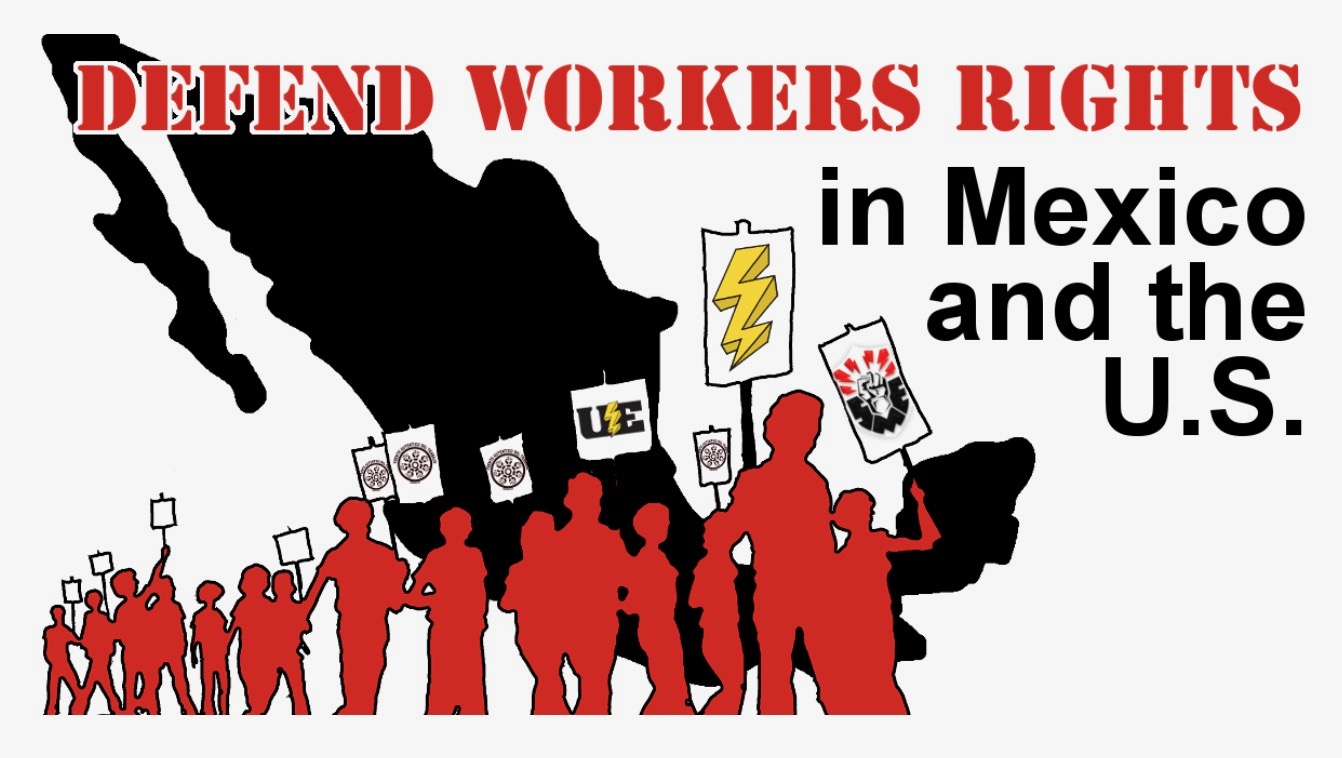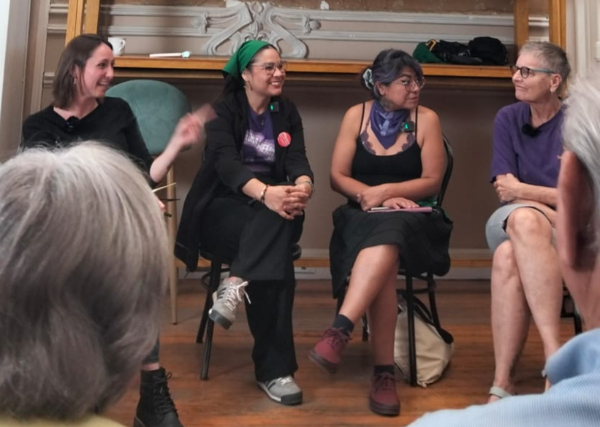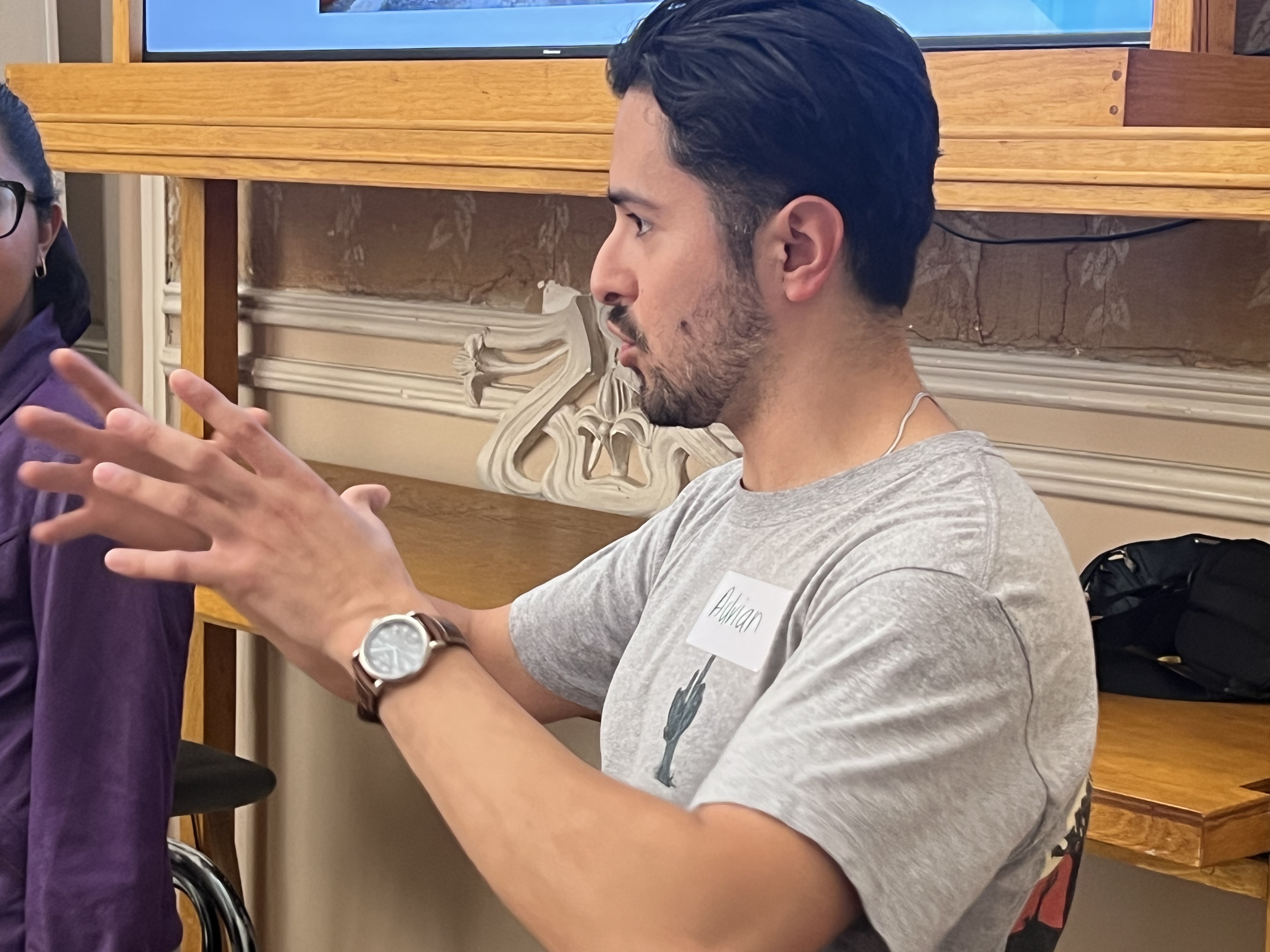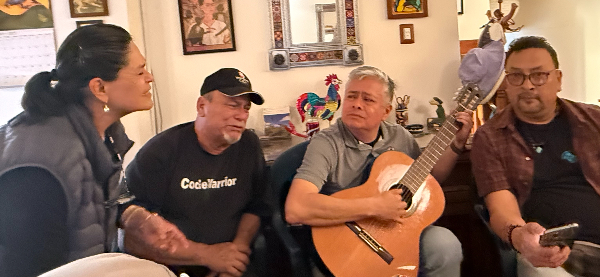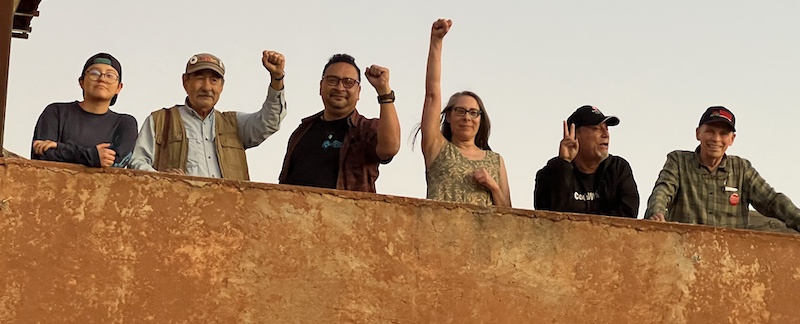|
|
The weekly newsletter of the Mexico Solidarity Project |
|
Every issue archived online at mexicosolidarityproject.org |
|
March 26, 2025 |
|
|
|
The Mexico Solidarity Project — in Guanajuato! |
|
Bruce Hobson, Co-Founder, Mexico Solidarity Project, for the editorial team |
|
|
Photo: Bruce Hobson |
|
When I proposed Guanajuato for our first in-person Mexico Solidarity Project (MSP) conference, one friend asked, “Why Guanajuato? We should hold this event in Mexico City, the political nerve center of the country.”
“True,” I said, “But in Guanajuato we supported one of the first successful independent union organizing drives since the new Mexican labor laws of 2019 and the USMCA. GM Silao workers formed SINTTIA. and threw out the corrupt CT union. We can go visit them in their headquarters!”
Guanajuato is also highly significant for its history of Mexican women’s struggle for reproductive rights. It is the home of Verónica Cruz, director of Las Libres, who delivered a powerful presentation on International Women’s Day at the conference.
The main part of our gathering was held in Guanajuato from March 7 to 9, Forty-some activists, labor leaders, worker center staffers, rank-and-file workers, feminists and journalists came from different parts of Mexico and the US. We shared stories on the top floor of a 200-year-old mansion once owned by an aristocratic French family — a much warmer setting than the usual university auditorium.
We heard presentations and unforgettable personal accounts. One worker’s story reminded us that the fight for worker power is far from won. Jaime Pulido León, a union leader and miner at Camino Roja in Zacatecas, recounted how he had to leave his job after a rival union run by the Sinaloa cartel forced him and his family at gunpoint to get out of town, or else.
We heard fighting words. Veteran Chicano activist Bill Gallegos told us that we must take Trump’s threats against Mexico with dead seriousness, and that Chicanos have always stood shoulder to shoulder with Mexico against US imperialist interventions — Bill’s words set a defiant tone and made us more determined than ever to build solidarity.
The ample time to relax, share meals and walk around the magnificent city of Guanajuato gave us time not just to learn, but to bond.
Of the participants, 15 then traveled to Mexico City for additional events. We were warmly welcomed at Morena’s offices by Morena General Secretary for Mexicans Abroad, Alejandro Robles.
The following day, in a van provided by Mexico City Mayor Clara Brugada, we got guided tours of two Utupía sites in Iztapalapa, her signature project that provides free recreational, social service and cultural spaces for the poorest of the poor.
Finally, to top off our list of remarkable meetings, we met in the Chamber of Deputies with Morena Congressional representatives living abroad. These visits opened up new possibilities for working across borders.
María Romero was an enthusiastic and knowledgeable contributor to the conference. You’ll enjoy her personal takeaways from an incredible week in Mexico! |
|
For a deeper dive into current news and analysis in English, check out our media website. And definitely see the new English podcast ¡Soberanía! (Sovereignty) with José Luis Granados Ceja and Kurt Hackbarth. |
|
Sin Muros is a weekly program dedicated to analyzing the Mexico-US relationship. An experienced team of journalists reports news, analysis and research from both sides of the border. Their cultural segments and interviews help to build understanding between Mexico and its migrant community. (English + Spanish) |
|
|
Don’t miss an issue! Sign up for a free Mexico Solidarity Bulletin subscription. |
|
|
Bio correction to last week's Voices: David Raby is the founder and coordinator of the UK Mexico Solidarity Forum, a sister organization to the MSP. |
|
Forging Solidarity in Guanajuato |
|
María Romero never expected she'd leave her native Mexico, but in her 30s, due to her political activities, she had to flee. Settling on the border in San Diego, she still regularly goes to Tijuana to see her family. She's passionate about assisting immigrants and adult learners and participates in community struggles organized through Activist San Diego. |
|
|
Most international conferences are held in Mexico City. Was Guanajuato a good site for a workers conference with a special focus on women workers?
Guanajuato is a beautiful and historic city. It’s where the Spanish first exploited the indigenous workers in the silver mines, and it’s also where they caught Padre Hidalgo, who began the worker and peasant revolution against the Spanish in 1810. They hung his head in a cage from the top of the Alhóndiga, a famous colonial building — you can still see the hook! |
|
|
International Women's Day, Guanajuato, Mexico 2025: photo: Bruce Hobson |
|
It was the right place to be on International Women’s Day, the right place for us all to march together. Guanajuato is a stronghold of the far right, and even now the right-wing PAN party, a fierce opponent of women’s rights, governs the state. |
|
|
Verónica Cruz with interpreter Iskra Vólkhina |
|
Verónica Cruz’s organization, Las Libres, has been working and organizing there for 25 years. She led the fight for women’s reproductive rights from this conservative city — and won! I bet if you asked any feminist whether they wanted to march in Mexico City or Guanajuato, they’d say, Guanajuato! |
|
On the first day, we all visited the Casa Obrera del Bajío, where the independent union SINTTIA has its offices. What did you learn from their presentation? |
|
First, the SINTTIA leadership is a team — they have a clear division of labor with a good structure. When they presented, they passed the mic to the presenter who could best answer our questions — how and where they’re organizing now, how SINTTIA became the first new independent auto union in Mexico organizing at General Motors, and what legal assistance they have. |
|
|
At Casa Obrera del Bajío, Silao |
|
When I’ve organized, I’ve always said to others, “I’m not fighting for everybody, I’m fighting for me. But if you want to come too, I’ll also be fighting for you.” |
|
|
Pablo Bernardo, Alejandra Morales, Esmeralda Alonso: Photo: Bruce Hobson |
|
That’s how Alejandra Morales, the General Secretary of SINTTIA, also organized. As a worker herself sharing the conditions of her fellow workers, she earned social authority, that is, respect and trust based on her consistently fighting for her own rights, and then others joined her.
I was also impressed that she could see what they did not have the capacity for. While bold, she wasn’t going to bite off more than they could chew. That’s what she said when asked if they would take on political campaigns. |
|
Her power, despite others looking down on her at first, comes from female power, emotional power. We are empathetic, we are nurturers — and we nurture movements. This form of power is usually hidden, but, in fact, it’s what brings people together.
How do you see the way Trump is trying to turn Mexican and US workers against each other? He’s threatening tariffs and deporting migrants, calling them criminals. |
|
Trump wants miserable people in the US to blame miserable people in Mexico for their misery. He wants the richest country in the world to blame one that is poor. He wants to deport Mexicans and other immigrants who are doing so much of the work the US depends on. Crazy! |
|
|
United Electrical Workers helps Mexican Workers defeat attacks on labor rights, 2018 |
|
Tariffs and migration are not the issues — the issue is the distribution of wealth! Mexico is helping migrants. For example many Haitians are staying in Mexico because the government is helping them find jobs and a place within our society. A third-world country is willing to help displaced people, while the richest country kicks them out.
I live on the border and know that for many decades, Mexicans have gone to the US for seasonal work. Mexicans come from farming traditions and are rooted to the land. We understand the cycle of agriculture and go across the border to help with harvest. Most don’t want to stay in the US; they just want to work for part of the year. Just give them the right to work!
Twenty-five years ago, when you were still living in Mexico, you met Verónica Cruz, who spoke at our conference. What was it like seeing her again?
I was in Baja California and worked on the case of Paulina, a pregnant 13-year-old girl who had been raped by at least two men. She requested an abortion, which was her legal right. But the Bishop and other pro-life people took her aside and lectured her. At the end, they asked her, “Do you still want to kill your baby?” She ended up having the baby. Verónica used this case in the Guanajuato campaign, asking, “What would you do if this was your daughter?” The campaign was able to preserve the right to abortion in the case of rape.
We had a panel on women’s issues in Mexico and the US. Are the issues the same? |
|
Yes, but the intensity and the circumstances are different. For example, a low-income US woman might go into a fancy store and get ignored. In Mexico, she wouldn’t even dare to go in — they stop themselves. In the US, women talk about their male partners not participating in housework. In Mexico, women are still fighting to stop getting killed by their partners. |
|
|
Caitlin Smith, facilitator, with Tania Díaz, Hortensia Escobar, Vicky Hamlin: Photo: Fabiola Ramírez |
|
I hear good women saying they don’t want to bring children into this world. But bad people are reproducing like bunnies! We need more people who can bring up good children to change the world!
How can we change people’s consciousness, so workers don’t fight each other, and women understand their power?
I believe the answer lies in social memory. Why are things the way they are? What did people do to win workers rights, civil rights and women’s rights? Like Verónica and decriminalizing abortion — that didn’t just happen. People need to remember — so they see that they can do it again. These reminders need to be everywhere in the public sphere.
One thing that makes binational solidarity difficult is language differences. How did that work — or not work! — at the conference? |
|
One-third of the people spoke Spanish only, one-third English only, and one-third were bilingual. On the first day, we used interpretation equipment with headphones, but we had too few headsets and some didn’t work well; we had to stop simultaneous translation. We appreciate that several conference participants just jumped up to help, including, for example, Luis Espinosa, from the UAW in Mexico, who is a certified interpreter! |
|
|
Adrían Martínez interpreting: Photo: Bruce Hobson |
|
|
María Romero, Agustín Arreola, Luis Espinosa, Gilberto García make music together. |
|
However, what was so wonderful was that several conference participants just jumped up to help. For example, it turned out that Luis Espinosa, from the UAW in Mexico, was a certified interpreter! |
|
This demonstrates what I feel was best about the conference. When problems came up, no one complained — they just helped solve the problem. With plenty of informal time, we bonded. At meals, we didn’t separate into US and Mexico or English and Spanish — we sat with whomever, and always a bilingual person was in the group and helped. At the end, we were united in our desire to see the Mexico Solidarity Project grow. The conference proved that solidarity is the best thing we have! |
|
|
Solidarity!: Photo: Bruce Hobson |
|
|
|
|
What Could Workers Win in a New NAFTA? |
|
|
Guest Reflection: Natascha Elena Uhlmann is a staff writer at Labor Notes. She’s one of the five coordinators of the Mexico Solidarity Project/Labor Note’s Labor Support Committee. This is excerpted from her January 24, 2025 article in Labor Notes. We highly recommend reading the whole article, which is available here in both English and Spanish: What Could Workers Win in a New NAFTA? |
|
In his nine years in the auto industry, Ben Hinsey has seen a lot of misplaced blame. The threat of job cuts is always looming. In fact, Hinsey transferred into his current job at the Stellantis Jeep factory in Toledo, Ohio, when his previous one at the Chrysler Toledo Machining Plant evaporated in 2017. He now installs instrument panels and serves as a float, moving from job to job to cover absences. Hundreds of thousands of auto jobs have disappeared from the US since the North American Free Trade Agreement in 1994 and its successor, the US-Mexico-Canada Agreement (USMCA). Wages plummeted as bosses threatened to close plants and move work south of the border. Many US autoworkers resent Mexican workers. “A lot of the spin on NAFTA is like, ‘It screwed US workers,’” Hinsey said. “But not really! It screwed over the workers everywhere.” . . . As long as workers in Mexico make only a fraction of US wages, bosses will leverage the threat to drive down US standards. “That was part and parcel of the contract givebacks that affected the United Auto Workers for decades,” said Scott Houldieson, an electrician who has worked at Ford Chicago Assembly for 35 years. After NAFTA, “we were always being told that we were lucky we have our jobs . . . lurking behind was the threat of moving product to Mexico.” Our members, who get paid roughly $35 an hour, have been asked to somehow figure out how they can compete with workers that make $3 an hour,” said Jason Wade, an assistant to UAW President Shawn Fain. “These companies cannot continue to be allowed to ‘compete’ based on how badly they screw over and pit Mexican and U.S. workers against each other.” Trump wants to renegotiate the USMCA now! [Editor’s note: NAFTA 2.0 — the USMCA — is scheduled for renegotiating in 2026, but Trump wants to do it sooner. This presents an opportunity to change the free trade agreement with revisions that can end the “race to the bottom.” Labor is newly feisty. The UAW refused to submit to demands for worker austerity with their “stand-up strikes” in 2023 and won. In Mexico, newly empowered by the labor provisions of the last USMCA and 2019 Mexican labor law reforms that protect the right of Mexican workers to form independent unions, Mexican workers are standing up too.] Mexican workers have held wildcat strikes and organized in the face of smears and intimidation. They’ve built independent, fighting unions — ousting management-aligned “protection” unions at General Motors Silao plant, a Saint Gobain auto parts facility in Cuautla, Morelos, and Goodyear’s San Luis Potosí facility, and waging a sustained strike at Caterpillar’s Nuevo Laredo facility. But it’s still an uphill climb. Workers have faced vote tampering, retaliation, and threats of violence. Even after reforms, “workers right to free association is often violated,” said Joaquin Guzman, the Saint-Gobain union’s general secretary. “Workers are fired, and often live with the fear of being fired, but much more so they fear the death threats against them and their families. We’d like to see USMCA reform have greater emphasis on that area.” A NEW CIO?
To reverse the downward trend of wages across the continent, North American unions will have to offer serious support to organizing in Mexico. Jeffery Hermanson, long time international labor solidarity activist, sees an opportunity similar to the US in the 1930s, when a massive campaign unionized blue-collar workers and formed what would become the Congress of Industrial Organizations. “The CIO hired 100 organizers,” he said. “And as a result, there was a UAW, there were rubber workers, steel workers, electrical workers, farm equipment workers, furniture workers — all of these industries were organized with 100 organizers. Mexico is equally good terrain for that kind of mass organizing campaign. “If North America is all gonna be one market, then unions need to be able to coordinate across it,” Hinsey said. |
|
|
|
|
Recent news reports and commentaries, from progressive and mainstream media, |
|
China is withholding approval for BYD’s Mexico plant due to tech concerns Mexico News Daily. The Chinese government is delaying approval for electric vehicle manufacturer BYD to build a plant in Mexico amid concerns that the company’s smart car technology could be accessed by the United States, according to the Financial Times.
Alonso Urrutia, Alejandro Alegría y Emir Olivares Se revirtió amenaza de la privatización energética La Jornada. Durante la celebración del 87 aniversario de la expropiación petrolera, la presidenta Claudia Sheinbaum promulgó las leyes secundarias en materia energética, con lo cual se revierte la reforma que se aprobó en 2013 en este sector.
Tony Leah, Tasks of the Working Class in the Trump Tariffs Crisis Solinet. Instead of seeing workers in other countries as our competitors for jobs, the first step should be to urgently arrange meetings and discussions between the CLC, the AFL-CIO, and the CTM (Confederación de Trabajadores de México), so we can identify our common interests and make common plans to stand against corporate interests.
Tony Wood, México: el nacimiento de un nuevo sistema político Diario Red. Por resumir los compromisos fundamentales del obradorismo, podríamos resaltar su rehabilitación del Estado como agente de desarrollo, la voluntad de reducir la desigualdad, la calificación moral de la corrupción como un ataque al bien público y el compromiso con la responsabilidad fiscal.
Digital Dirty War: Manipulation and Anonymity Resumen Latinoamericano – English. In just four days, unknown individuals or entities spent 20 million pesos on social network X to launch a smear campaign against President Claudia Sheinbaum Pardo and her predecessor AMLO.
Raúl Zibechi, El capitalismo es el asesino La Jornada. El primer punto es comprender que todos estamos en la mira del capital.
Mexico City bans violent bullfighting, sparking fury and celebration NPR. The decision sparked angry protests from bullfighting supporters and matadors, some of whom tried to breach a police barricade at the local Congress.
Alejandro Páez Varela, Exterminio y júbilo Sin Embargo. La realidad es que sólo hay una certeza sobre lo acontecido en el rancho Izaguirre de Teuchitlán: que NADIE, ni las fiscalías, saben qué pasó allí.
Mexico announces historic investment of €5.6 billion in strategic water projects Smart. This initiative, which will benefit 36 million inhabitants across the country, aims to guarantee the human right to water, in addition to recognising it as a strategic asset of the nation.
Iván Evair Saldaña, Corte confirma multa millonaria a 7 bancos por prácticas monopólicas La Jornada. La segunda sala de la Suprema Corte de Justicia de la Nación (SCJN) se negó ayer a amparar al Bank of America en México (BofA) contra la multa de 35 millones 75 mil pesos que la Comisión Federal de Competencia Económica (Cofece) le impuso, junto a seis bancos más, por incurrir en prácticas monopólicas absolutas para incrementar el precio de bonos del gobierno. |
|
|
|
|
The Mexico Solidarity Project brings together activists from various socialist and left organizations and individuals committed to worker and global justice. We see the 2018 election of Andrés Manuel López Obrador as president of Mexico as a watershed moment. AMLO and his progressive Morena party aim to end generations of corruption, impoverishment, and subservience to US interests. Our Project supports not just Morena, but all Mexicans struggling for basic rights, and opposes US efforts to undermine organizing and Mexico’s national sovereignty.
Editorial committee: Meizhu Lui, Bruce Hobson, Agatha Hinman, Victoria Hamlin, Courtney Childs, Pedro Gellert. To give feedback or get involved yourself, please email us! |
|
Subscribe! Get the Mexico Solidarity Bulletin in your email box every week. |
|
Web page and application support for the Mexico Solidarity Project from NOVA Web Development, a democratically run, worker-owned and operated cooperative focused on developing free software tools for progressive organizations. |

